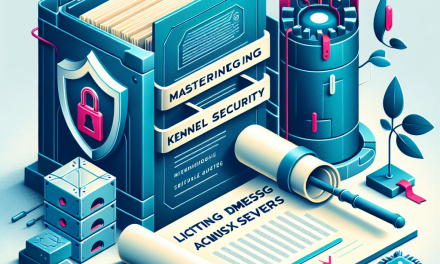In today’s digital landscape, maintaining the security of servers is paramount. Internet Control Message Protocol (ICMP), which is essential for network diagnostics and management, can also be exploited by malicious actors through various attack vectors, such as ICMP flood attacks. To mitigate these risks, implementing ICMP rate limiting on Linux servers is an effective strategy. This article delves into the importance of ICMP rate limiting and how to implement it on your Linux servers.
Understanding ICMP and Its Attack Vectors
ICMP is primarily used for sending error messages and operational information. Tools like ping utilize ICMP to verify whether a particular host is reachable. However, attackers can exploit ICMP for Denial of Service (DoS) attacks, flooding a targeted server with excessive ICMP requests. By overwhelming the server, attackers can degrade its performance and disrupt legitimate traffic.
Why Rate Limiting?
Rate limiting restricts the number of incoming ICMP packets, effectively reducing the possibility of ICMP-based attacks. By controlling the traffic, you can maintain service availability and enhance overall server security.
Prerequisites
- Root Access: You need administrative privileges to execute the necessary commands.
- Linux Distribution: This guide will illustrate configurations on systems using either
iptablesornftables, the two primary firewall frameworks on Linux.
Implementing ICMP Rate Limiting using iptables
iptables is a widely-used firewall utility for network traffic management in Linux. Here’s how to set up ICMP rate limiting:
-
Log in to your server as the root user or switch to a user with sudo privileges.
-
Check existing rules. It’s always good practice to review the current rules before making changes:
bash
sudo iptables -L -n -v -
Add ICMP rate limiting rule. You can specify the maximum number of ICMP packets allowed per second. The following command allows a maximum of 1 ping request per second:
bash
sudo iptables -A INPUT -p icmp –icmp-type echo-request -m limit –limit 1/sec –limit-burst 5 -j ACCEPT
sudo iptables -A INPUT -p icmp –icmp-type echo-request -j DROP--limit: Specifies the maximum rate.--limit-burst: Allows a burst of packets, helping to accommodate short spikes in traffic without dropping them immediately.
-
Save the rules to ensure they persist through reboots:
bash
sudo iptables-save | sudo tee /etc/iptables/rules.v4 -
Verify the new rules:
bash
sudo iptables -L -n -v
Implementing ICMP Rate Limiting using nftables
nftables is the successor to iptables and provides a more streamlined interface for managing firewall rules.
-
Install nftables if it’s not already installed:
bash
sudo apt install nftables -
Start the nftables service:
bash
sudo systemctl start nftables
sudo systemctl enable nftables -
Create or edit a ruleset:
- Open a text editor and create a file (for example,
/etc/nftables.conf):
bash
sudo nano /etc/nftables.conf
- Open a text editor and create a file (for example,
-
Add your ICMP rate limiting configuration:
nft
table ip filter {
chain input {
type filter hook input priority 0; policy accept;
ip protocol icmp icmp type echo-request limit rate 1/second burst 5 drop;
}
} -
Load the rules:
bash
sudo nft -f /etc/nftables.conf -
Verify your rules:
bash
sudo nft list ruleset
Monitoring and Testing
Once rate limiting is in place, it’s essential to test and monitor its effects:
-
Use
pingfrom another machine to verify the behavior:
bash
ping -c 10 -
Monitor the server logs to assess whether legitimate traffic is impacted or if malicious attempts are being dropped.
-
Tools like
vnstatoriftopcan help you visualize network traffic and the effectiveness of your rate limiting setup.
Conclusion
Implementing ICMP rate limiting on your Linux servers is a crucial step in bolstering your server’s security posture. By mitigating the risk of ICMP flood attacks, you ensure that your services remain available to legitimate users.
Deploying tools like iptables or nftables to enforce these configurations not only protects your server but also instills confidence among users that their data and access are prioritized. Keep your systems updated, regularly review your firewall rules, and remain vigilant against evolving security threats.
For further reads, stay updated with our articles on server security and best practices at WafaTech.





